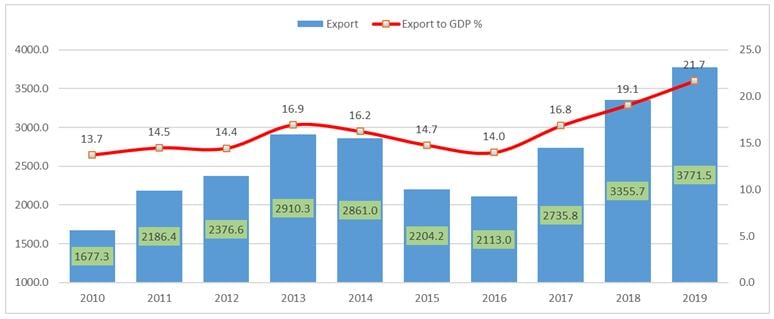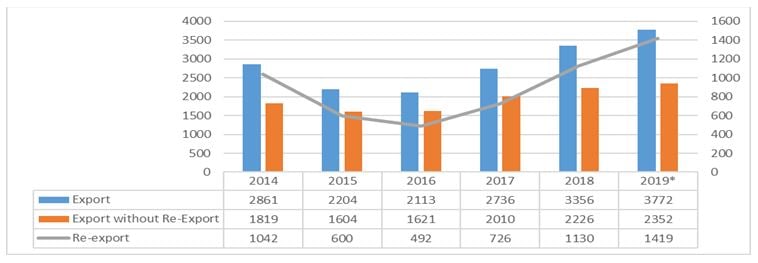Resume:
On the other hand, Natia Turnava stated that export was the driving force behind economic growth in 2019. The structure of the GDP is defined as follows: GDP = C + G + I +NX. In this formula, C is consumption, G is government spending, I is investment and NX is net export (export minus import). In order to see the full picture between the foreign trade dynamic and the GDP, it is important to analyse the net figure for export. In particular, this includes an integrated analysis on export, import and the trade deficit. After the year 2015, the import figure dropped the most in 2019 whilst the export figure increased the least since 2016. Therefore, improvements in foreign demand and export opportunities did indeed make a certain contribution to economic growth. At the same time, however, the important factor in 2019 as compared to the previous year is the drop in import which resulted in an increased figure for net export.
In the analysis of the export figure, it is important to determine the share of re-export in export which has a lesser economic effect as compared to the export of local goods. In 2019, export growth without re-export is relatively unimportant and constitutes USD 126 million. In this regard, previous years were quite successful and, consequently, the contribution of the share of export to economic growth was rather effective.
In turn, the Minister’s statement to consider a 5.2% growth as “high” is debatable and does not really correspond to the reality. However, the aforementioned part of the category is a judgment category and FactCheck cannot consider it in this analysis as a factor affecting the verdict. At the same time, as per FactCheck’s position, the current economic growth rate is unsatisfactory for Georgia as a developing country and does not really constitute a significant achievement.
Analysis
The Minister of Economy and Sustainable Development, Natia Turnava, whilst assessing preliminary data for economic growth, stated to the media: “In 2019, export was the main driving force behind our economic growth because in 2019 export reached a record high for the previous decades – it exceeded USD 3,771.5 million. It is precisely export that is a very driving force which brought about such economic growth.”
In this context, together with the absolute figure for export, it is important to analyse the relative figure; in particular, the export to the GDP ratio. The volume of the economy varies in different periods and, therefore, the objective criteria for success are also different.
Graph 1: Dynamic of Absolute and Relative Figures for Export in 2010-2019*[1], USD Million

Source: National Statistics Office of Georgia
In 2019, the export volume reached nearly USD 3.77 billion which constitutes 21.7% of Georgia’s GDP. In this regard, part of the Minister of Economy and Sustainable Development’s statement is indeed fair. However, it is importance to look at the part of the statement where Ms Turnava emphasises that “export is the driving force behind economic growth.” The structure of the GDP is defined as follows: GDP = C + G + I +NX. In this formula, C is consumption, G is government spending, I is investment and NX is net export (export minus import). In order to see the full picture between the foreign trade dynamic and the GDP, it is important to analyse the net export figure. In particular, this includes an integrated analysis on export, import and the trade deficit dynamic.
Table1: Net Export Structure in 2010-2019, USD Million
|
|
2010 |
2011 |
2012 |
2013 |
2014 |
2015 |
2016 |
2017 |
2018 |
2019 |
|
Export |
1 677 |
2 186 |
2 377 |
2 910 |
2 861 |
2 204 |
2 113 |
2 736 |
3 356 |
3 772 |
|
Import |
5 236 |
7 072 |
8 056 |
8 023 |
8 602 |
7 300 |
7 294 |
7 943 |
9 137 |
9 063 |
|
Trade Deficit |
-3 559 |
-4 886 |
-5 680 |
-5 112 |
-5 741 |
-5 096 |
-5 181 |
-5 207 |
-5 781 |
-5 292 |
|
Export % Change |
48.0% |
30.4% |
8.7% |
22.5% |
-1.7% |
-23.0% |
-4.1% |
29.5% |
22.7% |
12.4% |
|
Import % Change |
17.0% |
35.1% |
13.9% |
-0.4% |
7.2% |
-15.1% |
-0.1% |
8.9% |
15.0% |
-0.8% |
Source: National Statistics Office of Georgia
After the year 2015, the import figure dropped the most in 2019 whilst the export figure increased the least since 2016 when export decreased by 4.1%. On the other hand, the export figure reached record heights in 2016-2019. Therefore, improvements in foreign demand and export opportunities did indeed make a certain contribution to economic growth. At the same time, however, the important factor in 2019 as compared to the previous year is the drop in import which resulted in an increased figure for net export.
In the analysis of export indicators, it is important to determine the share of re-export in export. Export growth stipulates the GDP growth all things being equal. The effect of export goods production is reflected in other components as well – incomes increase and revenues are generated. Re-export has a lesser effect on job creation and an increase of production which needs to be taken into account whilst analysing export; that is, re-export is not a negative thing by itself and its growth is a positive change although the total benefit from re-export is naturally less as compared to export. Therefore, the growth of re-export has to be welcomed although its high share in the GDP structure is undesirable.
Graph 2: Export and Re-Export Dynamic in 2014-2019, USD Million

Source: National Statistics Office of Georgia
In 2019, export growth without re-export is relatively unimportant and constitutes USD 126 million. In this regard, previous years were quite successful and, consequently, the contribution of the export share to economic growth was rather effective.
[1] GDP 2019 forecast retrieved from the BDD document








